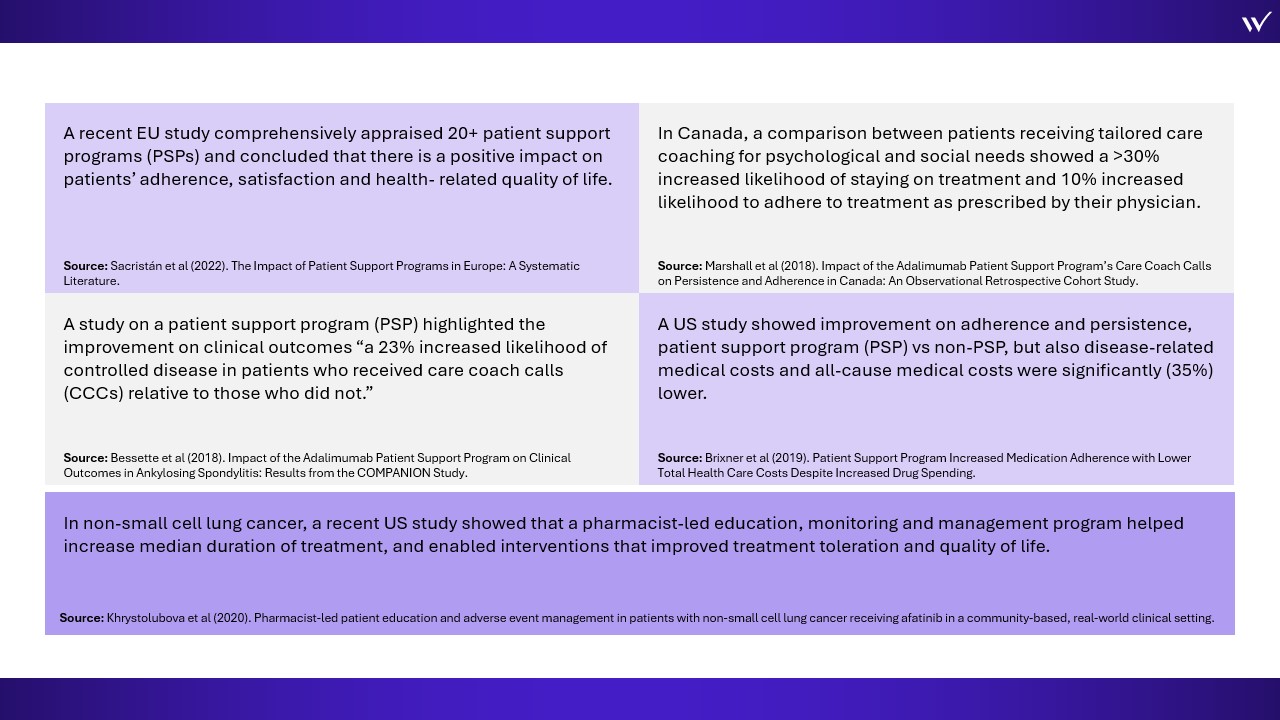Delivering better patient experiences and outcomes – the next generation of pharma patient support
Published May 17, 2024
- Life Sciences

The need for pharma to deliver better value for money through medication has perhaps never been more pressing. Healthcare costs are rising twice as fast as GDP growth in many countries and, in the US, nearly half of the adult population has at least one chronic illness (opens in a new tab).
Against this background, it is estimated that half of medications for chronic diseases are not taken as directed (opens in a new tab), and many struggle to continue with their treatment as prescribed.
Evidence indicates that providing targeted support for those chronic patients on treatment can positively impact adherence and outcomes, in turn generating value for health systems through fewer hospitalizations and lower morbidity and mortality rates. The benefit from greater adherence appears to be a win-win, yet in our experience, only a minority of pharma companies are effectively realizing the opportunity for patient support. Research shows that only a small proportion of potentially eligible patients are currently using support programs (opens in a new tab), primarily due to a lack of awareness regarding their availability.
This article is written by Wavestone’s patient experience experts, exploring how pharma companies can do more for people that are on their treatment, and what practical steps can be taken to get there.
What is the case for patient support delivered by pharma?
Services that deliver meaningful change for patients go beyond basic access and education resources to deliver interventions that address the holistic needs of the individual. These services are often delivered within a formalized patient support program (PSP) which we define as a coordinated set of interventions that are aimed at improving outcomes and experience.
Depending on the disease and treatment journey, key components of PSPs could include emotional care and counselling, adherence training & assistance, lifestyle & nutrition advice, symptom & side effect tracking and remote monitoring solutions – all potentially delivered in a synchronized, interactive and personalized way.
The case for actively providing these services revolves around 3 main ideas:
Patient beliefs, attitudes, and preferences regarding healthcare, treatment options, and lifestyle choices play a significant role in treatment adherence and engagement, which in turn impact on outcomes.
“It is critical to see the person behind the patient. This is the only way to truly understand the complex mix of physical, emotional and social challenges someone living with a chronic condition encounters on a daily basis. These challenges can significantly impact quality of life and ability to adhere to, and persist with, the treatments prescribed to them”. Dr Nicola Davies, Behavioral Scientist and patient support expert.
These challenges vary at an individual level and are often further impacted by societal factors that differ across borders. Factors such as health literacy, support networks including family centricity and social stigma of some diseases, play a greater role in some countries than in others.
Organized PSPs provide the means for pharma companies to address individual needs in a coordinated way, with the more sophisticated organizations timing the support according to the individual, with delivery at the precise moment they need it.
There is growing evidence that PSPs can have a positive impact on patient experience and clinical outcomes.
Pharma has the advantage over other players (new tech companies, health care providers, patient organizations) of truly understanding their medications and treatment journeys.
As such, they are arguably best placed to design programs of support that complement – not impinge upon – health provision and positively impact on outcomes. And, unlike national governments, big pharma has the advantage of being able to deliver patient-focused services internationally.
There is additional value to be gained beyond better patient outcomes: deeper patient insights, real world evidence, improved patient centricity, reputation and ultimately improved bottom line through greater treatment persistence.


Traditionally, holistic patient support is often not seen as the ‘space’ for pharma companies, but they are in the unique position of having the expertise, capability and incentive to deliver impactful improvements – many are already doing it.
Delivering patient support effectively – 6 practical recommendations
Despite the investment, there are many examples of patient support solutions that fall short of making a difference and often center around single solutions such as apps or educational websites.
By contrast, we have seen that integrated programs based on need really can positively impact patients. Drawing on our experience across multiple big pharma, we make six recommendations to avoid common pitfalls and effectively deliver patient support.
Spend time defining the challenge and the desired outcomes. Define the potential value for all stakeholders, while acknowledging the barriers and complexities that lie ahead, and do this long before solutions are introduced. Once the ‘why’ is agreed upon, then discussions with leadership and key functions become consistent, rather than dominated by compliance and ROI challenges.
Research and evidence the underlying patient needs and identify the challenges that may impact on their ability to benefit from treatment. Gaining HCPs (Healthcare Professionals) view on how best to complement their practice and what their expected outcomes are will be important too. Only when this is all done, should you start considering solutions – the trap of starting with the (usually digital) solution remains all too common!
Acknowledge the different levels of health system provision and support needs per market. Identify a few pilot market archetypes to co-create with – this will help to create a standardized, above-country patient support ‘menu’ which can be tailored to local needs.
Often left to local markets, the communication strategy should be designed early so that HCP and patient awareness of the available support (and its value) is maximized. In practice, we have seen that when a PSP is integrated into the product’s brand strategy, it is less likely to be seen internally as a separate value-add that may become deprioritized over time. And by contrast, where there is no coordinated communication effort, especially to HCPs, it is not uncommon to see a take-up of less than 5% of patients on treatment.
Data collection is clearly not the primary purpose of PSPs. However, this doesn’t mean RWE (Real World Evidence) should only be seen as an ancillary benefit over the long-term. In fact, leading pharma organizations have transparent data strategies, with the clear rationale of using the data to build up evidence to support care pathway transformation.
Whereas traditional PSPs are often deployed as bolt-on initiatives to brand plans, next generation PSPs require a more comprehensive, patient-centric approach. Think ‘above brand’ – while patient support interventions clearly need to be tailored to individual medications and patients, the ‘framework’ that service options are drawn from can be the same. Not only does this provide economies of scale but it also provides both patients and HCPs with a consistent experience.


